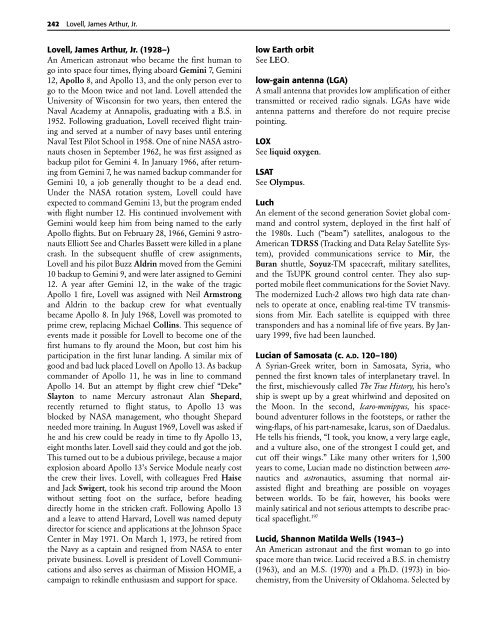The Complete Book of Spaceflight: From Apollo 1 to Zero Gravity
The Complete Book of Spaceflight: From Apollo 1 to Zero Gravity
The Complete Book of Spaceflight: From Apollo 1 to Zero Gravity
You also want an ePaper? Increase the reach of your titles
YUMPU automatically turns print PDFs into web optimized ePapers that Google loves.
242 Lovell, James Arthur, Jr.<br />
Lovell, James Arthur, Jr. (1928–)<br />
An American astronaut who became the first human <strong>to</strong><br />
go in<strong>to</strong> space four times, flying aboard Gemini 7, Gemini<br />
12, <strong>Apollo</strong> 8, and <strong>Apollo</strong> 13, and the only person ever <strong>to</strong><br />
go <strong>to</strong> the Moon twice and not land. Lovell attended the<br />
University <strong>of</strong> Wisconsin for two years, then entered the<br />
Naval Academy at Annapolis, graduating with a B.S. in<br />
1952. Following graduation, Lovell received flight training<br />
and served at a number <strong>of</strong> navy bases until entering<br />
Naval Test Pilot School in 1958. One <strong>of</strong> nine NASA astronauts<br />
chosen in September 1962, he was first assigned as<br />
backup pilot for Gemini 4. In January 1966, after returning<br />
from Gemini 7, he was named backup commander for<br />
Gemini 10, a job generally thought <strong>to</strong> be a dead end.<br />
Under the NASA rotation system, Lovell could have<br />
expected <strong>to</strong> command Gemini 13, but the program ended<br />
with flight number 12. His continued involvement with<br />
Gemini would keep him from being named <strong>to</strong> the early<br />
<strong>Apollo</strong> flights. But on February 28, 1966, Gemini 9 astronauts<br />
Elliott See and Charles Bassett were killed in a plane<br />
crash. In the subsequent shuffle <strong>of</strong> crew assignments,<br />
Lovell and his pilot Buzz Aldrin moved from the Gemini<br />
10 backup <strong>to</strong> Gemini 9, and were later assigned <strong>to</strong> Gemini<br />
12. A year after Gemini 12, in the wake <strong>of</strong> the tragic<br />
<strong>Apollo</strong> 1 fire, Lovell was assigned with Neil Armstrong<br />
and Aldrin <strong>to</strong> the backup crew for what eventually<br />
became <strong>Apollo</strong> 8. In July 1968, Lovell was promoted <strong>to</strong><br />
prime crew, replacing Michael Collins. This sequence <strong>of</strong><br />
events made it possible for Lovell <strong>to</strong> become one <strong>of</strong> the<br />
first humans <strong>to</strong> fly around the Moon, but cost him his<br />
participation in the first lunar landing. A similar mix <strong>of</strong><br />
good and bad luck placed Lovell on <strong>Apollo</strong> 13. As backup<br />
commander <strong>of</strong> <strong>Apollo</strong> 11, he was in line <strong>to</strong> command<br />
<strong>Apollo</strong> 14. But an attempt by flight crew chief “Deke”<br />
Slay<strong>to</strong>n <strong>to</strong> name Mercury astronaut Alan Shepard,<br />
recently returned <strong>to</strong> flight status, <strong>to</strong> <strong>Apollo</strong> 13 was<br />
blocked by NASA management, who thought Shepard<br />
needed more training. In August 1969, Lovell was asked if<br />
he and his crew could be ready in time <strong>to</strong> fly <strong>Apollo</strong> 13,<br />
eight months later. Lovell said they could and got the job.<br />
This turned out <strong>to</strong> be a dubious privilege, because a major<br />
explosion aboard <strong>Apollo</strong> 13’s Service Module nearly cost<br />
the crew their lives. Lovell, with colleagues Fred Haise<br />
and Jack Swigert, <strong>to</strong>ok his second trip around the Moon<br />
without setting foot on the surface, before heading<br />
directly home in the stricken craft. Following <strong>Apollo</strong> 13<br />
and a leave <strong>to</strong> attend Harvard, Lovell was named deputy<br />
direc<strong>to</strong>r for science and applications at the Johnson Space<br />
Center in May 1971. On March 1, 1973, he retired from<br />
the Navy as a captain and resigned from NASA <strong>to</strong> enter<br />
private business. Lovell is president <strong>of</strong> Lovell Communications<br />
and also serves as chairman <strong>of</strong> Mission HOME, a<br />
campaign <strong>to</strong> rekindle enthusiasm and support for space.<br />
low Earth orbit<br />
See LEO.<br />
low-gain antenna (LGA)<br />
A small antenna that provides low amplification <strong>of</strong> either<br />
transmitted or received radio signals. LGAs have wide<br />
antenna patterns and therefore do not require precise<br />
pointing.<br />
LOX<br />
See liquid oxygen.<br />
LSAT<br />
See Olympus.<br />
Luch<br />
An element <strong>of</strong> the second generation Soviet global command<br />
and control system, deployed in the first half <strong>of</strong><br />
the 1980s. Luch (“beam”) satellites, analogous <strong>to</strong> the<br />
American TDRSS (Tracking and Data Relay Satellite System),<br />
provided communications service <strong>to</strong> Mir, the<br />
Buran shuttle, Soyuz-TM spacecraft, military satellites,<br />
and the TsUPK ground control center. <strong>The</strong>y also supported<br />
mobile fleet communications for the Soviet Navy.<br />
<strong>The</strong> modernized Luch-2 allows two high data rate channels<br />
<strong>to</strong> operate at once, enabling real-time TV transmissions<br />
from Mir. Each satellite is equipped with three<br />
transponders and has a nominal life <strong>of</strong> five years. By January<br />
1999, five had been launched.<br />
Lucian <strong>of</strong> Samosata (c. A.D. 120–180)<br />
A Syrian-Greek writer, born in Samosata, Syria, who<br />
penned the first known tales <strong>of</strong> interplanetary travel. In<br />
the first, mischievously called <strong>The</strong> True His<strong>to</strong>ry, his hero’s<br />
ship is swept up by a great whirlwind and deposited on<br />
the Moon. In the second, Icaro-menippus, his spacebound<br />
adventurer follows in the footsteps, or rather the<br />
wing-flaps, <strong>of</strong> his part-namesake, Icarus, son <strong>of</strong> Daedalus.<br />
He tells his friends, “I <strong>to</strong>ok, you know, a very large eagle,<br />
and a vulture also, one <strong>of</strong> the strongest I could get, and<br />
cut <strong>of</strong>f their wings.” Like many other writers for 1,500<br />
years <strong>to</strong> come, Lucian made no distinction between aeronautics<br />
and astronautics, assuming that normal airassisted<br />
flight and breathing are possible on voyages<br />
between worlds. To be fair, however, his books were<br />
mainly satirical and not serious attempts <strong>to</strong> describe practical<br />
spaceflight. 197<br />
Lucid, Shannon Matilda Wells (1943–)<br />
An American astronaut and the first woman <strong>to</strong> go in<strong>to</strong><br />
space more than twice. Lucid received a B.S. in chemistry<br />
(1963), and an M.S. (1970) and a Ph.D. (1973) in biochemistry,<br />
from the University <strong>of</strong> Oklahoma. Selected by







